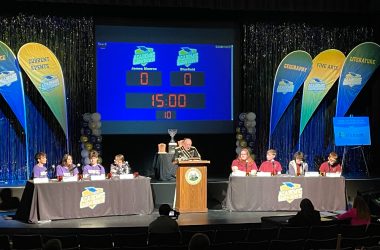By MARY STORTSTROM
The Journal
SHEPHERDSTOWN, W.Va. — Angie Francart has turned her personal love of horses into creating a haven of care for thoroughbreds that have retired from racing, often saving them from an inhumane end.

(Photo by Mary Stortstrom)
Francart and her husband, Gary, are the co-owners of Sleeping Fox Farm a nonprofit rescue farm, located near Shepherdstown. She said they purchased the property in 2002 and began living there in 2003. Francart, who grew up around horses and rode professionally, said she wanted to start small.
“Two of the horses were actually transferred to us with the property. I told Gary I just wanted a few horses in the yard — and it turned into a lot more than that,” she said. “(Gary) says it’s like potato chips: I couldn’t have just one or two.”
But Francart does not collect horses for the sake of having a full stable. It was her studying for a nursing degree — along with her fascination with the thoroughbred racing industry — that led her to creating a nonprofit rescue facility.
“I kind of started learning about thoroughbreds. I knew about racing, but I didn’t know much about the thoroughbred industry and how it works. The more I learned about it, the more I realized there was a need for horses that are coming off the track that don’t have a second career to have a place to go,” Francart said. “I was working on my dissertation and I decided to write my doctorate about thoroughbreds off the track. I learned about the good, the bad and the ugly of the industry, and the plight of the thoroughbred.”
“It’s generally a pretty short career, and most horses are done racing by the time they are between three to five years old. The average lifespan of a horse is around 32 years, so owning a horse is a lifetime commitment,” she said. “The problem is, what happens to a horse once it is off the track? That’s where we come in.”
Francart said the Jockey Club, which is the governing body of the thoroughbred industry, has become very active in creating and certifying thoroughbred retirement programs throughout the United States. She said she is trying to get Sleeping Fox Farm accredited through the Jockey Club.
However, thoroughbreds without a second career often end up at auction, according to Francart — sometimes going to slaughterhouses or meat markets in foreign countries.
An off-the-track thoroughbred can have many second chances, including staying active in competitive horse shows. Francart said one of the horses on the U.S. equestrian team in the 2016 Rio Olympics was an off-the-track thoroughbred.
Francart said retired racehorses are often used in therapeutic riding programs, as show horses or adopted by responsible owners.
Francart said not all owners, trainers and breeders understand the level of care — or the financial cost — associated with caring for a thoroughbred. She said there are good and bad owners, but most of the horses that end up at her farm come in injured, starved, abused or neglected.
“The problem with these horses is they’re a commodity; it is an industry. People use them, make money off them and throw them out. I’ve been in the industry of rescuing horses for 11 years, and sometimes I’m still shocked by what I see,” she said.
One horse in particular, “Petite,” came to Sleeping Fox Farm nine years ago, starving. When Francart took her to the veterinarian, she was told the horse’s left front knee was fused from multiple injuries from racing.
“The doctors looked at her X-ray and said, ‘Oh my gosh.’ We’ve been managing her on pain medication for nine years and she’s doing OK, eating and walking around with the other horses,” Francart said.
“What we do sometimes brings a lot of heartache because we can’t save all the horses, and we have lost some. It’s heart-wrenching because you’re fighting for them. I remember when Petite first got here, she was such a bad case she went into seizures. She went into the hospital for three weeks. I remember sitting out in the field with her head in my lap, holding her and crying. I said, ‘I’m not giving up on you, you’re going to get through this.’ Nine years later, she’s still with us.”
Though a horse’s racing career can be short and dangerous, Francart said seeing the formerly injured or abused horses she has taken in through the years become healthy and happy is its own reward.
“All of these horses are living out a much-needed, comfortable retirement. I want to give them the care they deserve,” Francart said. “It’s a lot of money and a lot of hard work, but we do it for the love of the horses.”
See more from The Journal





